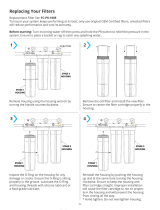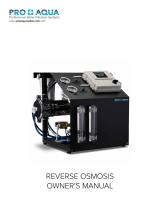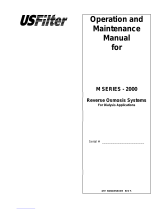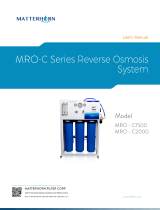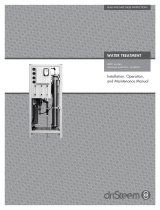Page is loading ...

IOM-WQ-PWR8024
Series PWR8024
Installation, Operation
and Maintenance Manual
Commercial Reverse Osmosis Systems
Series PWR8024
!
CAUTION: Please read the entire manual before proceed-
ing with the installation and startup. Your failure to follow any
attached instructions or operating parameters may lead to the
product’s failure, which can cause property damage and/or
personal injury.
• Do not use where the water is microbiologically unsafe.
• Pretreatment must be sufficient to eliminate chemicals that
would attack the membrane materials.
• Always turn off the unit, shut off the feed water, and discon-
nect the electrical power when working on the unit.
• Never allow the pump to run dry.
• Never start the pump with the reject valve closed.
• Never allow the unit to freeze or operate with a feed water
temperature above 100°F.
Save manual for future reference.
Please refer to Section 6 of this manual for operating parameters
according to your specific feed water Silt Density Index (SDI). For all
other settings according to your specific feed water quality, please
contact your Watts representative. A chemical analysis of the feed
water should be conducted prior to the initial sizing and selection of
this system.
Notes
Changes in operating variables are beyond the control of Watts. The
end user is responsible for the safe operation of this equipment.
The suitability of the product water for any specific application is the
responsibility of the end user.
Successful long-term performance of an RO system depends on
proper operation and maintenance of the system. This includes
the initial system startup and operational startups and shutdowns.
Prevention of fouling or scaling of the membranes is not only a mat-
ter of system design, but also a matter of proper operation. Record
keeping and data normalization are required in order to know the
actual system performance and to enable corrective measures when
necessary. Complete and accurate records are also required in case
of a system performance warranty claim.
Changes in the operating parameters of an RO system can be
caused by changes in the feed water or can be a sign of trouble.
Maintaining an operation and maintenance log is crucial in diagnos-
ing and preventing system problems. For your reference, a typical log
sheet is included in this manual.
PURE WATER
Table Of Contents
I. Introduction
A. Specifications . . . . . . . . . . . . . . . . . . . . . . . . . . . . . . . . . . . . . 2
B. Overview. . . . . . . . . . . . . . . . . . . . . . . . . . . . . . . . . . . . . . . . . 2
C. Pre-treatment . . . . . . . . . . . . . . . . . . . . . . . . . . . . . . . . . . . . . 3
II. Controls, Indicators, and Components
A. General System Component Identification – Figure #1 . . . . . . 3
B. Electrical Connection – Figure #2 . . . . . . . . . . . . . . . . . . . . . . 4
III. Operation
A. Installation. . . . . . . . . . . . . . . . . . . . . . . . . . . . . . . . . . . . . . . . 5
B. Plumbing Connections . . . . . . . . . . . . . . . . . . . . . . . . . . . . . . 5
C. Electrical Connections . . . . . . . . . . . . . . . . . . . . . . . . . . . . . . 5
D. Startup . . . . . . . . . . . . . . . . . . . . . . . . . . . . . . . . . . . . . . . . . . 5
E. Controllers . . . . . . . . . . . . . . . . . . . . . . . . . . . . . . . . . . . . . . . 6
F. Operation and Maintenance Log . . . . . . . . . . . . . . . . . . . . . . . 7
G. Troubleshooting . . . . . . . . . . . . . . . . . . . . . . . . . . . . . . . . . 8-9
IV. Replacement Parts List. . . . . . . . . . . . . . . . . . . . . . . . . . . . . . 10
V. Membrane Replacement . . . . . . . . . . . . . . . . . . . . . . . . . . . . 11
VI. Appendix
Flow Rate Guidelines. . . . . . . . . . . . . . . . . . . . . . . . . . . . . . . . . 11
Temperature Correction Factors . . . . . . . . . . . . . . . . . . . . . . . . 11
Note: Do not use with water that is microbiologically unsafe or
of unknown quality without adequate disinfection before or after
the system.

2
I. Introduction
The separation of dissolved solids and water using RO membranes
is a pressure driven temperature dependent process. The membrane
material is designed to be as permeable to water as possible while
maintaining the ability to reject dissolved solids.
The main system design parameters require the following:
• Internal flows across the membrane surface must be high enough
to prevent settling of fine suspended solids on the membrane
surface.
• The concentration of each dissolved ionic species must not exceed
the limits of solubility anywhere in the system.
• Pre-treatment must be sufficient to eliminate chemicals that would
attack the membrane materials.
A. Specifications
RO Membrane
Feed Water Product Water
Reject Water
B. RO Overview
Reverse osmosis systems utilize semipermeable membrane ele-
ments to separate the feed water into two streams. The pressurized
feed water is separated into purified (product) water and concentrate
(reject) water. The impurities contained in the feed water are carried
to drain by the reject water.
MODEL NUMBER PWR80243085 PWR80243125 PWR80243165 PWR80243205
Maximum Productivity (gallons per minute) 40 60 80 100
Quality (typical membrane percent rejection) 99%
Recovery (adjustable) 65% - 75%
Membrane Size 8" x 40"
Membrane Array (four elements per vessel) 1:1 2:1 2:2 3:2
Prefilter (system ships with five micron cartridges) 7 round x 40" 7 round x 40"
Feed Water Connection 2" Flange 2.5" Flange 3" Flange
Product Water Connection 2" Flange 2.5" Flange
Reject Water Connection 1.5" Flange
Feed Water Required (GPM at 65% recovery) 62 93 123 154
Minimum Feed Water Pressure 20 PSIG 20 PSIG 20 PSIG 20 PSIG
Drain Required (maximum) 62 93 123 154
460 VAC, 3-phase, 60Hz (other voltages available) 25 amps 30 amps 35 amps 40 amps
Motor Horse Power (TEFC Motor) 15 20 25 30
Dimensions L x W x H (approximate) 186" x 26" x 72"
Shipping Weight (estimated pounds) 2500 2800 3200 3500
Notes:
• Maximum production based on a feed water of 77° F, SDI < 3,
1000 ppm TDS, and pH 7.6.
Individual membrane productivity may vary (± 15%). May be
operated on other feed waters with reduced capacity.
• Percent Rejection is based on membrane manufactures specifi-
cations; overall system percent rejection may be less.

3
C. Pretreatment
The RO feed water must be pretreated in order to prevent mem-
brane damage and/or fouling. Proper pretreatment is essential for
reliable operation of any RO system.
Pretreatment requirements vary depending on the nature of the feed
water. Pretreatment equipment is sold separately. The most common
forms of pretreatment are described below.
Media Filter - Used to remove large suspended solids (sediment)
from the feed water. Backwashing the media removes the trapped
particles. Backwash can be initiated by time or differential pressure.
Water Softener - Used to remove calcium and magnesium from
the feed water in order to prevent hardness scaling. The potential
for hardness scaling is predicted by the Langelier Saturation Index
(LSI). The LSI should be zero or negative throughout the unit unless
approved anti-scalents are used. Softening is the preferred method
of controlling hardness scale.
Carbon Filter - Used to remove chlorine and organics from the
feed water. Free chlorine will cause rapid irreversible damage to the
membranes.
The residual free chlorine present in most municipal water supplies
will damage the thin film composite structure of the membranes
used in this unit. Carbon filtration or sodium bisulfite injection should
be used to completely remove the free chlorine residual.
Chemical Injection - Typically used to feed antiscalant, coagulant,
or bisulfite into the feed water or to adjust the feed water pH.
Prefilter Cartridge - Used to remove smaller suspended solids and
trap any particles that may be generated by the other pretreatment.
The cartridge(s) should be replaced when the pressure drop across
the housing increases 5 - 10 psig over the clean cartridge pressure
drop. The effect of suspended solids is measured by the silt density
index (SDI) test. An SDI of five (5) or less is specified by most mem-
brane manufacturers and three (3) or less is recommended.
Iron & Manganese - Iron should be removed to less than 0.1 ppm.
Manganese should be removed to less than 0.05 ppm. Special me-
dia filters and/or chemical treatment is commonly used.
pH - The pH is often lowered to reduce the scaling potential.
Silica: Reported on the analysis as SiO2. Silica forms a coating on
membrane surfaces when the concentration exceeds its solubility.
Additionally, the solubility is highly pH and temperature dependent.
Silica fouling can be prevented with chemical injection and/or reduc-
ing the recovery.
II. Controls, Indicators, and
Components
(See Figure 1)
A. General System Component Identification
A Controller - Controls the operation of the system and displays
the product water quality.
B Reject Control Valve - Controls the amount of reject flow.
C Reject Recycle Control Valve – Controls the amount of reject
recycle flow.
D Pump Discharge Valve - Used to throttle the pump.
E Prefilter Inlet Pressure Gauge - Indicates the inlet pressure of the
prefilter.
F Pump Suction Pressure Gauge – Indicates the prefilter outlet
and pump suction pressure. The difference between this gauge
and the prefilter inlet gauge is the prefilter differential pressure of
the prefilter.
G Pump Discharge Pressure Gauge - Indicates the pump dis-
charge pressure.
H Membrane Feed Pressure Gauge – Indicates the membrane
feed pressure.
I Reject Pressure Gauge - Indicates the reject pressure.
J Reject Flow Meter - Indicates the reject flow rate in gallons per
minute (gpm).
K Reject Recycle Flow Meter – Indicates the reject recycle flow in
gpm.
L Product Flow Meter - Indicates the product flow rate in (gpm).
M Prefilter Housing - Contains the RO prefilters.
N Automatic Inlet Valve - Opens when pump is on and closes
when the pump is off.
O RO Feed Pump - Pressurizes the RO feed water.
P RO Membrane Vessels - Contains the RO membranes.
Q Motor starter / transformer enclosure.
Figure 1

4
Figure 2
Electrical Connection
460 Volt 3-phase
Power Inlet
To Pump
B. Electrical Connection

5
III. Operation
A. Installation
1. The water supply should be sufficient to provide a minimum of
20 psig pressure at the design feed flow.
2. Proper pretreatment must be determined and installed prior to
the RO system.
3. A fused high voltage disconnect switch located within 10 feet of
the unit is recommended. This disconnect is not provided with
the RO system.
4. Responsibility for meeting local electrical and plumbing codes
lies with the owner /operator.
5. Install indoors in an area protected from freezing. Space al-
lowances for the removal of the membranes from the pressure
vessels should be provided. This system requires 42" minimum
clear space on each side.
B. Plumbing Connections
Note: It is the responsibility of the end user to ensure that the
installation is done according to local codes and regulations.
1. Connect the pretreated feed water line to the inlet side of the
prefilter housing. (Figure # 1 item # 1) A feed water shutoff valve
should be located within 10 feet of the system.
2. Temporarily connect the outlet of the product water flow meter
to drain. (Figure # 1 item # 2) The product water line should
never be restricted. Membrane and/or system damage may oc-
cur if the product line is blocked.
3. Connect the outlet of the reject water flow meter to a drain. (Fig-
ure # 1 item # 3) The reject drain line should never be restricted.
Membrane and/or system damage may occur if the reject drain
line is blocked. An air gap must be located between the end
of the drain line and the drain. The use of a standpipe or other
open drain satisfies most state and local codes and allows for
visual inspection and sampling.
C. Electrical
Note: It is the responsibility of the end user to ensure that the
installation is done according to local codes and regulations.
1. A safety switch or fused disconnect should be installed within
10 feet of the system. The disconnect and fuses should be sized
accordingly.
2. Verify that the disconnect switch is de-energized using a
voltmeter.
3. Connect the outlet of the disconnect switch to the top of the
motor starter relay. (Figure #1 item Q and Figure #2). Attach the
power supply ground to the controller ground.
4. Do not apply power to the RO unit at this time.
D. Startup
1. Verify that the pretreatment equipment is installed and working
properly. Verify that no free chlorine is present in the feed water.
2. Verify that the controller on/off switch is in the off position.
3. Close the pump discharge completely then open it one turn.
Note: All valves on this unit turn clockwise to close.
4. Install five micron filter cartridges in the prefilter housing.
5. Open the reject control valve completely by turning it counter-
clockwise.
6. Close the reject recycle control valve completely by turning it
counterclockwise.
7. Open the feed water shutoff valve installed in step III-B-1 above.
8. Engage the safety switch or disconnect (installed in step III-C-1
above) to apply electrical power to the RO system.
9. Turn the key switch on by rotating it clockwise. Press the power
button. There will be a 10 second delay and the pump will start.
Press the power button as soon as the pump starts to shut it
down and look at the motor fan as the pump stops to determine
if the pump rotation is correct. The fan should rotate in the direc-
tion indicated by the rotation arrow on the pump. Continue with
the startup if the pump is rotating in the proper direction. If the
pump rotation is backwards, reverse the rotation by shutting off
the power and swapping any two of the three power lines con-
nected in step III.C.3 above. Verify correct pump rotation before
continuing with startup.
10. Turn the system on and allow the product and reject water to go
to drain for 15 minutes.
11. Adjust the reject control valve, the reject recycle control valve
and the pump discharge valve until the desired flows are
achieved. Closing the reject valve increases the recycle and
product flow and decreases the reject flow. Closing the reject
recycle valve increases the reject and product flow and de-
creases the recycle flow. Opening the pump discharge valve
increases all of the flows. See the temperature correction table in
the appendix to determine the flow rates for different operating
temperatures.
12. Allow the product water to flow to drain for 30 minutes.
13. Turn off the system and connect the product line to the point of
use. The product water line should never be restricted. Mem-
brane and/or system damage may occur if the product line is
blocked.
14. Restart the system and record the initial operating data using the
log sheet in the next section.
15. See the controller section for detailed information about the
controller.

6
E. Controllers
See Seperate Booklet
Back off needle
valve to vent air.
Retighten to 25 in.-
lbs. when vent port
runs a steady stream
of water.
Vented
Priming
Plug
Drain
Plug
Note: It is very important to vent the mechanical seal
during startup. Failure to vent the seal may result in
premature seal failure.

7
F. PWR8024 Operation and Maintenance Log
DATE PRODUCT
GPM
REJECT GPM PUMP
DISCHARGE
PRESSURE
REJECT
PRESSURE
FEED TDS PPM PRODUCT TDS
PPM
FEED WATER
TEMP
FEED WATER
HARDNESS
FEED WATER
CHLORINE LEVEL
PRE FILTER
INLET PRESSURE
PRE FILTER
OUTLET
PRESSURE
REMARKS
Note: Change the prefilter when the differential pressure increases by 5 - 10psi over the clean differential pressure.
Clean the RO membrane(s) when the product flow drops by 15% or more. (See appendix)

8
G. Troubleshooting
RO Troubleshooting Guide
SYMPTOMS
SALT PASSAGE PERMEATE FLOW PRESSURE DROP LOCATION POSSIBLE CAUSES VERIFICATION CORRECTIVE ACTION
Normal to increased Decreased Normal to increased Predominantly
first stage
Metal oxide Analysis of metal ions in
cleaning solution.
Improved pretreatment to remove met-
als. Cleaning with acid cleaners.
Normal to increased Decreased Normal to increased Predominantly
first stage
Colloidal fouling SDI measurement of feed/
X-ray diffraction analysis of
cleaning sol. residue.
Optimize pretreatment system for
colloid removal. Clean with high pH,
anionic detergent formulation.
Increased Decreased Increased Predominantly
last stage
Scaling (CaSO
4, CaSO3,
BaSO
4, SiO2)
Analysis of metal ions in
cleaning sol. Check LSI of
reject. Calculate maximum
solubility for CaSO
4, BaSO4,
SiO
2 in reject analysis.
Increase acid addition and scale
inhibitor for CaSO
3 and CaSO4. Reduce
recovery. Clean with an acid formula-
tion for CaCO
3, CaSO4 and BaSO4.
Normal to moderate
increase
Decreased Normal to moderate
increase
Can occur in any
stage
Biological fouling Bacteria count in permeate
and reject. Slime in pipes
and vessels.
Shock dosage of sodium bisulfite.
Continuous feed of low conc. bisulfite
at reduced pH. Peracetic acid steriliza-
tion. Clean with alkaline anionic sur-
factant. Chlorine dosage upstream with
dechlorination. Replace cartridge filters.
Decreased or mod-
erately increased
Decreased Normal All stages Organic fouling Destructive testing, e.g. IR
reflection analysis.
Optimization of pretreatment system
(e.g. coagulation process.) Resin/
activated carbon treatment. Clean with
high pH detergent.
Increased Increased Decreased Most severe in
the first stage
Chlorine oxidant attack Chlorine analysis of feed.
Destructive element test.
Check chlorine feed equipment and
dechlorination equipment.
Increased Increased Decreased Most severe in
the first stage
Abrasion of membrane by
crystalline material
Microscopic solids analysis
of feed. Destructive ele-
ment test.
Improved pretreatment. Check all filters
for media leakage.
Increased Normal to increased Decreased At random O-ring leaks, End or side
seal glue leaks.
Probe test. Vacuum test.
Colloidal material passage.
Replace O-rings. Repair or replace
elements.
Increased Normal to low Decreased All stages Conversion too high. Check flows and pressures
against design guidelines
Reduce conversion rate. Calibrate
sensors. Increase analysis and data
collection.

9
Motor Troubleshooting Chart
PROBLEM POSSIBLE CAUSE CORRECTIVE ACTION
Motor fails to start Blown fuses Replace fuses with proper type and rating
Overload trips Check and rest overload in starter.
Improper power supply Check to see that power supplied agrees with motor nameplate and load factor.
Open circuit in winding or control switch Indicated by humming sound when switch is closed.
Mechanical failure Check to see if motor and drive turn freely. Check bearing and lubrication.
Short circuited stator Indicated by blown fuses. Motor must be rewound.
Poor stator coil connection Remove end bells, locate with test lamp.
Rotor defective Look for broken bars or end ring.
Motor may be overloaded Reduce load.
Motor Stalls One phase connection Check lines for open phase.
Wrong application Change type or size. Consult manufacturer.
Overload motor Reduce load.
Low motor voltage See that nameplate voltage is maintained. Check connection.
Open circuit Fuses blown, check overload relay, stator and push buttons.
Motor runs and then dies down Power failure Check for loose connections to line, to fuses and to control.
Motor does not come up to speed Not applied properly Consult supplier for proper type.
Voltage too low at motor terminals because of line drop. Use higher voltage on transformer terminals or reduce load. Check connections. Check
conductors for proper size.
Broken rotor bars or loose rotor. Look for cracks near the rings. A new rotor may be required as repairs are usually temporary.
Motor takes too long to accelerate Open primary circuit Locate fault with testing device and repair.
Excess loading Reduce load.
Poor circuit Check for high resistance.
Defective squirrel cage rotor Replace with new rotor.
Applied voltage too low Get power company to increase power tap.
Wrong rotation Wrong sequence of phases reverse connections at motor or at switchboard.
Motor overheats while running
under load
Overloaded reduce load.
Frame or bracket vents may be clogged with dirt and
prevent proper ventilation of motor.
Open vent holes and check for a continuous stream of air from the motor.
Motor may have one phase open Check to make sure that all leads are well connected.
Grounded could Locate and repair.
Unbalanced terminal voltage Check for faulty leads, connections and transformers.
Motor vibrates after correcting
have been made
motor misaligned Realign
Weak support Strengthen base.
Coupling out of balance Balance coupling.
Driven equipment unbalanced Rebalance driven equipment.
Defective ball bearing Replace bearing.
Bearing not in line Line properly.
Balancing weights shifted Rebalance motor.
Polyphase motor running single phase Check for open circuit.
Excessive end play Adjust bearing or add washer.
Unbalanced line current on
polyphase motors during normal
operation
Unequal terminal volts Check leads and connections
Single phase operation Check for open contacts
Scraping noise Fan rubbing air shield Remove interference.
Fan striking insulation Clear fan.
loose on bedplate Tighten holding bolts.
Noisy operation Airgap not uniform Check and correct bracket fits or bearing.
Rotor unbalance Rebalance.
Hot bearings general Bent or sprung shaft Straighten or replace shaft.
Excessive belt pull Decrease belt tension.
Pulleys too far away Move pulley closer to motor bearing.
Pulley diameter too small Use larger pulleys.
Misalignment Correct by realignment of drive.
Hot bearings ball Insufficient grease Maintain proper quantity of grease in bearing.
Deterioration of grease, or lubricant contaminated Remove old grease, wash bearings thoroughly in kerosene and replace with new grease.
Excess lubricant Reduce quantity of grease: bearing should not be more than ½ filled.
Overloaded bearing Check alignment, side and end thrust.
Broken ball or rough races Replace bearing: first clean housing thoroughly.
These instructions do not cover all details or variations in equipment nor provide for every possible condition to be
met in connection with installation, operation or maintenance. Chart courtesy of Marathon Electric.

10
RO System Troubleshooting
PROBLEM CORRECTIVE ACTION
General
High Product Water TDS
Membrane expanded. Replace membrane.
Membrane attack by chlorine Carbon pre-filter may be exhausted. Replace with a new cartridge.
Clogged pre-filter-creates pressure drop and low reject flow. Replace pre-filter cartridge.
Feed pressure too low. Feed pressure must be at least 20psi.
Insufficiently flushed post-filter cartridge. Flush post-filter with pure water.
Brine seal on membrane leaks. Determine if seal or o-ring is bad. Replace as needed.
No Product Water or Not Enough Product Water
Feed water shut off. Turn on feed water.
Low feed pressure. Feed pressure must be at least 20psi. Consider booster pump.
Pre-filter cartridge clogged. Replace pre-filter cartridge.
Membrane fouled. Determine and correct cause; replace membrane.
Product check valve stuck. Replace check valve fitting.
Low pump discharge pressure Open pump discharge valve, replace pump
ITEM NUMBER DESCRIPTION QUANTITY PER SYSTEM
PWR80243085 PWR80243125 PWR80243165 PWR80243205
1 Pre filter housing 7 round 40" 1 1 1 1
2 Pressure Gauge, 2 1/2", 0-100 psi, LF, Back Mount 2 2 2 2
3 Pressure Gauge, 2 1/2", 0-400 psi, LF, Back Mount 3 3 3 3
4 Flow Meter 2 - 20 gpm 1 1
5 Flow Meter 4 – 40 gpm 1 1
6 Flow Meter 6 - 60 gpm 2 1
7 Flow Meter 10 - 80 gpm 1 1 1
8 Flow Meter 15-130 gpm 1 1
9 Controller with conductivity meter (optional) 1 1 1 1
10 Pump & Motor, 3-Phase, 60Hz, 15 hp 1
11 Pump & Motor, 3-Phase, 60Hz, 20 hp 1
12 Pump & Motor, 3-Phase, 60Hz, 25 hp 1
13 Pump & Motor, 3-Phase, 60Hz, 30 hp 1
14 Low Pressure Switch 1 1 1 1
15 Inlet Solenoid Valve 24 volt, 2” 1
16 Inlet Solenoid Valve 24 volt, 3” 1 1 1
17 RO Membranes 8 12 16 20
18 Pre Filter Cartridges 40” 5 micron 7 7 7 7
IV. Replacement Parts List

11
VI. Appendix
The following tables are intended as a guide to determining the flow
rates for the PWR8024 series RO systems. All flows are in gallons
per minute (GPM).
Nominal flows for systems with reject recycle and a feed water
Silt Density Index less than 3.
MODEL NUMBER PWR80243085 PWR80243125 PWR80243165 PWR80243205
Product (max) 40 60 80 100
Reject 25 35 45 55
MODEL NUMBER PWR80243085 PWR80243125 PWR80243165 PWR80243205
Product (max) 34 51 68 85
Reject 19 28 37 46
MODEL NUMBER PWR80243085 PWR80243125 PWR80243165 PWR80243205
Product (max) 40 60 80 100
Reject 14 20 27 34
Reject Recycle 11 15 18 21
MODEL NUMBER PWR80243085 PWR80243125 PWR80243165 PWR80243205
Product (max) 34 51 68 85
Reject 12 17 23 29
Reject Recycle 7 11 14 17
V. Membrane Replacement
1. Turn off the system and close the feed water shutoff valve.
2. Disconnect the membrane feed hoses by loosing the brass fit-
tings between the end of the hoses and the pressure vessel end
caps.
3. Remove the retaining rings from the pressure vessels.
4. Push the old membrane out of the vessel in the direction of the
feed flow.
5. Record the serial numbers of the new membranes.
6. Lightly lubricate the brine seals on the new membranes with
clean water.
7. I nstall the new membranes in the direction of flow with the brine
seal end going in last.
Note: Be sure to install an interconnector between the mem-
branes in each pressure vessel.
8. Lightly lubricate the end cap internal and external o-rings with
glycerin.
9. Install the end caps and secure them with the retaining rings.
10. Install the membrane feed hoses.
11. Verify that all retaining rings are installed.
12. Follow the start up procedure in section III-D.
Brine
Seal
Flow Direction
Membrane
Nominal flows for systems with reject recycle and a feed water
Silt Density Index less than 3.
Nominal flows for systems not using reject recycle and a feed
water Silt Density Index of 3 to less than 5.
Nominal flows for systems with reject recycle and a feed water
Silt Density Index of 3 to less than 5.
°C °F CORRECTION FACTOR
30 86 1.16
29 84.2 1.13
28 82.4 1.09
27 80.6 1.06
26 78.8 1.03
25 77 1.00
24 75.2 0.97
23 73.4 0.94
22 71.6 0.92
21 69.8 0.89
20 68 0.86
19 66.2 0.84
18 64.4 0.81
17 62.6 0.79
16 60.8 0.77
15 59 0.74
14 57.2 0.72
13 55.4 0.70
12 53.6 0.68
11 51.8 0.66
10 50 0.64
9 48.2 0.62
8 46.4 0.61
7 44.6 0.59
6 42.8 0.57
5 41 0.55
Multiply the nominal product flow at 25° C by the temperature correction factor to
determine the flow at various other temperatures.
Temperature Correction Factors

IOM-WQ-PWR8024 1105 EDP# 2915861 © 2011 Watts
USA: North Andover, MA • Tel. (800) 224-1299 • www.watts.com
Canada: Burlington, ON • Tel. (888) 208-8927 • www.wattscanada.ca
A Watts Water Technologies Company
LIMITED WARRANTY: Certain Watts Pure Water products come with a limited warranty from Watts Regulator Co. Other products may have no warranty or are covered by the original manufacturer’s
warranty only. For specific product warranty information, please visit www.watts.com or the published literature that comes with your product. Any remedies stated in such warranties are exclusive and
are the only remedies for breach of warranty. EXCEPT FOR THE APPLICABLE PRODUCT WARRANTY, IF ANY, WATTS MAKES NO OTHER WARRANTIES, EXPRESS OR IMPLIED. TO THE FULLEST EXTENT
PERMITTED BY APPLICABLE LAW, WATTS HEREBY SPECIFICALLY DISCLAIMS ALL OTHER WARRANTIES, EXPRESS OR IMPLIED, INCLUDING BUT NOT LIMITED TO THE IMPLIED WARRANTIES OF
MERCHANTABILITY AND FITNESS FOR A PARTICULAR PURPOSE, AND IN NO EVENT SHALL WATTS BE LIABLE, IN CONTRACT, TORT, STRICT LIABILITY OR UNDER ANY OTHER LEGAL THEORY, FOR
INCIDENTAL, INDIRECT, SPECIAL OR CONSEQUENTIAL DAMAGES, INCLUDING, WITHOUT LIMITATION, LOST PROFITS OR PROPERTY DAMAGE, REGARDLESS OF WHETHER IT WAS INFORMED ABOUT
THE POSSIBILITY OF SUCH DAMAGES.
/
